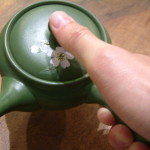Just as we love to explore the history, culture, and various types of tea, we also are fascinated by the variety available in tea accessories. There are of course many different shapes and sizes of teapots available in western cultures but these are so, well… familiar. We love exploring tea and stories of tea from all sides. If you enjoy green tea then an experience not to be missed is that of the Japanese Kyusu. This small, by Western standards, teapot is excellent for steeping your favorite green tea. It provides an experience of multiple rapid steepings and is ideal for sharing green tea with several friends or guests at once. Correctly steeping green tea in a kyusu will yield a fresh umami (subtle savory taste) flavor without the overwhelming grassy flavor or bitterness often associated with green tea.
About the Japanese Kyusu
Teapots themselves are believed to have originated in China out of necessity for brewing the camellia sinensis (tea) leaf and evolved from there. As tea was brought to Japan by monks, teapots naturally followed. Over time the Japanese experimented and developed their own teapots, producing them from kilns that have been in operation since approximately 1100 CE. In Japan, the sencha style of tea has developed over hundreds of years. Unlike Chinese green tea which is pan fired to stop oxidation, sencha is a steamed product, with some varieties being light steamed (asamushi sencha) and some deep steamed (fukamushi sencha). Sencha is normally steeped at cooler temperatures and has less uniformity in leaf size with many smaller particles coming from the slight leaf breakdown that comes with steaming.In any case, Japanese teapots have evolved over time to support brewing this style of green tea.
The term kyusu literally means teapot in Japanese and generally refers to a small clay teapot used for brewing green tea. While the kyusu is generally considered to be a teapot with a large conical handle attached to the side it turns out this is actually a yokode kuysu. There are also ushirode kyusu that looks like a traditional western teapot with the handle attached to the back, uwade kyusu which has a handle on the top, and houhin kyusu which doesn’t feature a handle at all. The yokode kyusu is the most distinctive to westerners though all can be considered works of art. Indeed, if you appreciate the artistry of the kyusu you will find any number of colors and styles available from skilled craftsmen.
Green Tea Steeped with a Yokode Kyusu
Preparing Japanese green tea with a kyusu is simple though it is a bit different than brewing with single use teabags or hard infusers. To get started it is best to have some kind of cooling pitcher since we want the water to be around 160-180 degrees Fahrenheit. Pouring hot water from a teapot or kettle into a cooling vessel will quickly allow the water to cool to the desired range after only a couple minutes or so.
Add 6-8 grams or about a tablespoon and a half of Japanese green tea. Although this style teapot is normally associated with Japanese sencha green tea it can be used with most other varieties including bancha and gyokuro. For what should be obvious reasons this teapot isn’t a good choice for matcha.
Steeping with a kyusu is intended for multiple rapid steepings, so add the water to your kyusu and steep for 25 to 30 seconds. When pouring a little gentle rocking of the pot will ensure the contents are well mixed and balanced throughout. Pour a little into each cup and then return to add a bit more so that each cup ultimately gets an even balance of flavor and umami.
Be sure to pour out all the liquid so the leaves don’t sit in hot water. When ready, infuse a second and even third time.
Finally, be sure to remove all the tea leaves and rinse out your kyusu with cold water. Do not use soap to wash your kyusu or use it to make other kinds of tea as the clay absorbs and retains a little bit of the green tea with each steeping, flavoring the teapot as its used.













